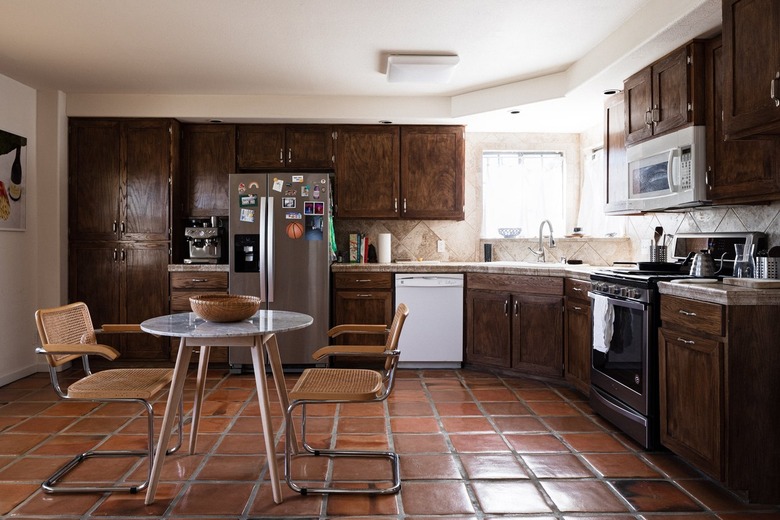Can You Stain Terra-Cotta Tile Floors?
Terra-cotta refers to a group of soft, red clay tiles that are usually handmade. They can be Mexican, Brazilian or French tiles. While most terra-cotta tiles take on a distinct look, you can also find some variations in color, texture and sizing, from the traditional to a dramatic black terra-cotta tile. Nearly all terra-cotta tiles are sold unsealed, which is good news if you want to change the look of them. With no protective barrier over the extremely porous clay, the tiles soak up stain easily for a new look.
Tip
You can stain terra-cotta tiles as long as they haven't been sealed. If they have been sealed, you have to strip the sealer before staining.
Use Wood Stain
Use Wood Stain
One option for changing the color of the tiles is to use wood stain. Depending on the type of terra-cotta, its porosity and the final color you want, you may have to apply several coats. First, test the stain on a sample tile, allowing the stain to dry thoroughly between each coat to see the final color change. Since all tiles are a little different, this test run helps you figure out how much stain to use and if it will turn out how you envisioned it. Once you get the color you want, allow the tiles to dry, then seal the top coat with a terra-cotta sealer.
Darken and Seal
Darken and Seal
It's also possible to darken and change the color of the terra-cotta while sealing the tile. This is a permanent color change and may result in a more traditional color for the floor. A color-enhancing sealer that deepens the natural color of the terra-cotta is one choice. This topical sealer darkens the tiles to the color they appear when wet. It's applied after you grout the tiles. Boiled linseed oil is another option to stain or darken terra-cotta tiles. Apply one or two coats as the tiles are installed to protect them and darken their color at the same time.
Accidental Staining Concerns
Accidental Staining Concerns
If you like the appearance of your terra-cotta and do not wish to apply a stain or change the color, be warned that unless they are treated during installation, your tiles may stain anyway. Terra-cotta tiles can be stained by water, footprints and grout. Food, foot traffic and day-to-day living also may severely stain the tiles if they aren't properly sealed. Seal the tiles as they are laid, immediately prior to grouting, or after grouting if a grout release has been used. Reapply the sealer yearly to help prevent future stains.
Preparation for Tile Stain
Preparation for Tile Stain
Before you apply a stain or try to enhance the color of the terra-cotta clay tiles, make sure the tile is ready to take the new color. Tiles must be clean and dry with no existing layer of wax or sealer in place.
If this is a new, just-installed floor, it can be stained or sealed immediately. If you're staining an older floor, apply a terra-cotta stripper to its surface. This removes any wax, previous impregnating sealers that did not affect the color, or any color-enhancing sealers that have faded or were undesirable. When the stripped tiles have been rinsed and completely dried, apply the stain or enhancer. Tiles appear lighter in color when they are dry.
Staining terra-cotta clay tiles is a cost-effective way to change the look of your tiles without losing the distinct feel of terra-cotta. Test out different tile stain methods on a sample tile to find a look that you like.
